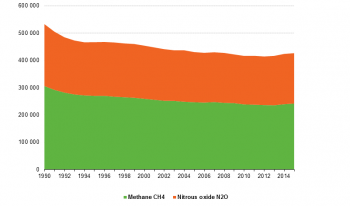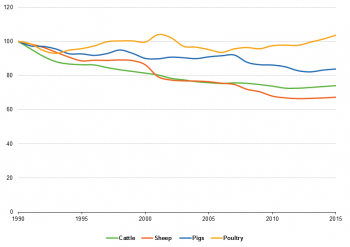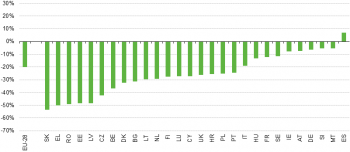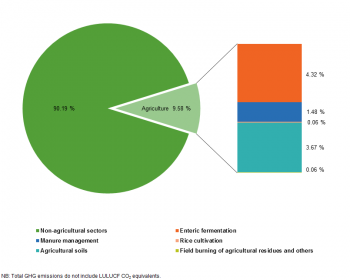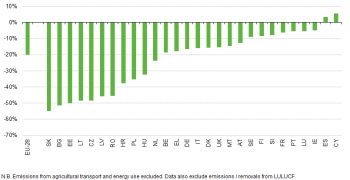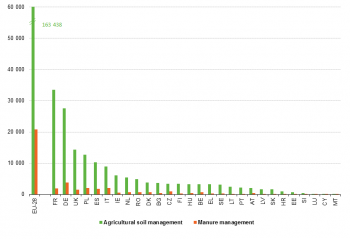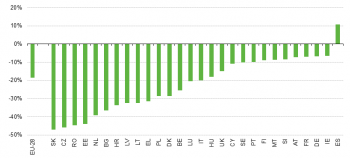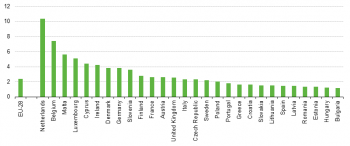Archive:Agri-environmental indicator - greenhouse gas emissions
- Data from September 2017 for the period 1990 - 2015.
This Statistics Explained article is a fact sheet of the European Union (EU) agri-environmental indicator greenhouse gas emissions. It consists of an overview of recent data, complemented by all information on definitions, measurement methods and the context needed to interpret the data correctly. This article is part of a set of similar fact sheets providing a complete picture of the state of the agri-environmental indicators in the EU.
The indicator measures the aggregated annual emissions from agriculture of methane (CH4) and nitrous oxide (N2O). Emissions are shown relative to data for the year 1990 and are expressed as CO2 equivalents.
Main Indicator:
- Greenhouse gas (GHG) emissions from agriculture (kilotonnes of CO2 equivalents per year)
Supporting Indicator:
- Share (%) of agriculture in GHG emissions
Main statistical findings
there is a mixture of "percentage points" and "percentage" - not yet fixed
Key messages
- The agricultural sector produced 426 743 kilotonnes of CO2 equivalent of greenhouse gases in 2015, around 10 % of the total EU emissions (excluding Land Use, Land Use Change and Forestry (LULUCF) net removals) for that year. Emissions from the agricultural sector have declined by 20 % since 1990.
- The reduction in greenhouse gas emissions has been mainly due to a 17 % reduction in nitrous oxide emissions from agricultural soils due to a decrease in the use of nitrogenous fertilisers, and a 22 % decrease in methane enteric fermentation emissions caused by a reduction in livestock numbers.
Assessment
Total emissions from the EU agricultural sector
The agricultural sector produced 426 473 kilotonnes of CO2 equivalent of non-CO2 greenhouse gases in 2015, a 20 % reduction compared with 1990 emissions. Between 1990 and 2015, emissions of methane and nitrous oxide from agriculture decreased by 21 % and 19 %, respectively (Figure 1, Figure 7, Figure 9). The majority of this reduction was due to the combination of lower nitrous oxide emissions from agricultural soils (17 % lower), mainly due to a decline in the use of nitrogenous fertilisers, and reduced methane enteric fermentation emissions (22 % lower), due to an overall reduction in livestock numbers i.e. cattle and sheep (Figure 2 and Figure 3). In 2015, the EU agricultural sector contributed 10 % of the total EU greenhouse gas emissions (Figure 4).
Many of the emission reductions have been offset, at least in part, by increased production outside the EU. Imports of food and drink into the EU have, for example, increased significantly since 1990.
Although the total decrease in agricultural non-CO2 emissions across the EU-28 was -20 % between 1990 and 2015, individual Member States showed widely varying trends (Figure 5). Based on the official data reported by the Member States, Slovakia (-55 %), Bulgaria (-51 %) and Estonia (-50 %) achieved the largest reductions in relative terms.
In contrast, Cyprus (+6 %) and Spain (+4 %) were the only two Member States for which emissions of greenhouse gases from agriculture increased between 1990 and 2015. This is largely explained by their expanding livestock numbers during this period, particularly pigs (Cyprus) and cattle, pigs and poultry (Spain).
Methane emissions from the EU agricultural sector
Enteric fermentation of feed in the stomachs of livestock (particularly cattle) is the largest single source of CH4 in the EU-28. Emissions of methane across the EU-28 from agriculture decreased by 64 304 kilotonnes of CO2 equivalents between 1990 and 2015, a reduction of 21 % compared with 1990 levels. Emissions from the two major sources of methane, enteric fermentation and manure management showed a 22 % and a 17 % decrease, respectively. The main factor behind the absolute reduction in emissions has been the economic transformation in newer EU Member States and reduced numbers of ruminant livestock (i.e. cattle and sheep) due to greater efficiencies in the livestock sector (e.g. a 26 % decrease in cattle numbers has occurred across the EU-28 between 1990 and 2015, sheep numbers have decreased more, by 33 %) (Figure 2).
The share of methane emissions that occur from enteric fermentation or manure management also varies between Member States (Figure 6). France is the largest emitter of methane from enteric fermentation and accounted for 18 % of all EU-28 emissions of CH4 from this source in 2015. Germany and the United Kingdom followed, with a 13 % and 12.5 % share, respectively. Differences between countries are generally due to the types and numbers of livestock held within each country coupled with other factors such as climatic and stock feed differences.
Across the EU-28, almost all countries reduced emissions of CH4 from agriculture between 1990 and 2015. In relative terms, Bulgaria (-70 %) and Slovakia (-64 %) had the largest percentage decreases during this period (Figure 7). Cyprus (+17 %), Spain (+7 %) and Luxembourg (+1.6 %) were the only Member States that reported increased methane emissions during this period. The larger increases in methane emissions observed in Cyprus and Spain are at least partially linked to increases in ruminant animal numbers (cattle and/or swine, respectively) that occurred between 1990 and 2015.
Nitrous oxide emissions from the agricultural sector
Nitrous oxide emissions from agricultural soils are the largest source of N2O in the EU-28. Emissions of N2O from this source have decreased by 19 % between 1990 and 2015, largely due to a general lower use of nitrogen fertiliser on farmland in the majority of Member States during this period (Figure 3).
Emissions of nitrous oxide varied widely across the Member States between 1990 and 2015 (Figure 8). In absolute terms, France as the leading agriculture producer in the EU is the largest emitter of N2O, responsible for 20 % of all EU-28 agricultural emissions of N2O in 2015. Germany (17 %), the United Kingdom (9 %) and Poland (8 %) are also significant emitters. Four Member States have reported large reductions of N2O from the agriculture sector between 1990 and 2015, reducing emissions by 40 % or more (Figure 9): Slovakia (-47 %), Czech Republic (-46 %), Romania (-45 %) and Estonia (-44 %).
Changes in agricultural practices in a number of Member States have led to relative differences in the amount of N2O emitted. However it is necessary to interpret trends of N2O emissions in the Member States with care as a number of countries have methodological problems with estimating N2O emissions from agricultural soils.
Greenhouse gas emissions per utilised agricultural area (UAA)
Figure 10 shows the aggregated emissions of CH4 and N2O expressed per utilised agricultural area (UAA). This analysis provides one measure of the intensity of agricultural activity within a country, and illustrates how the varying land use and agricultural practices across the EU-28 results in variations in emissions intensity occurring. Four Member States, the Netherlands, Belgium, Malta, and Luxembourg have significantly higher emissions per UAA than the other EU-28 Member States, and more than twice that of the EU-28 average, which reflects the higher intensification of agricultural activities within these three countries.
Data sources and availability
Indicator definition
Aggregated annual emissions from agriculture of methane (CH4) and carbon dioxide (N2O). Emissions are shown relative to data for the year 1990 and are expressed as CO2 equivalents.
Measurements
Main indicator:
- GHG emissions from agriculture (kilotonnes of CO2 equivalents per year)
Supporting indicator:
- Share (%) of agriculture in GHG emissions
Links with other indicators
This indicator has links to a number of other AEI indicators that describe developments in some of the main contributory factors that affect emissions of greenhouse gases from the agricultural sector.
Data used and methodology
Emissions data used in this indicator is from the official national total and sectorial greenhouse gas emissions data submissions reported annually by Member States to United Nations Framework Convention on Climate Change (UNFCCC), EU Greenhouse Gas Monitoring Mechanism and EEA European Environment Information and Observation Network (EIONET). For the EU, the data are compiled by the EEA in the report (and related database) “European Union Greenhouse Gas Inventory 1990-2015 and Inventory Report 2017”. The supporting livestock and fertiliser use data are also from the 2017 annual official national greenhouse gas data submissions under the EU Greenhouse Gas Monitoring Mechanism and EEA/EIONET. Utilised agricultural area (UAA) data are from Eurostat annual crop statistics. Recommended default methodologies for emission data collection are compiled in the IPCC Guidelines for National Greenhouse Gas Inventories.
Each country estimates GHG emissions based on volume of activities (e.g. livestock numbers, agricultural practices) and associated emission factors. The annual aggregated emissions of CH4 and N2O are weighted using their respective 100-year Global Warming Potential (GWP) coefficients (25 for CH4, 298 for N2O). Data are expressed in kilotonnes CO2 equivalent. Carbon dioxide emissions do not include emissions from fossil fuel combustion sources that arise from agricultural-related processes such as transport, greenhouse heating and grain drying. Such sources are inventoried in Intergovernmental Panel on Climate Change (IPCC) under the Energy section, but the individual contribution of agriculture is not inventoried. Under the agreed international guidelines for estimating emissions of greenhouse gases, countries are encouraged to use country-specific methods wherever possible as this leads to improved emission estimates. The different methods used by countries can sometimes mean that data are not fully comparable between countries. Care should therefore be taken when analysing the trends between countries.
Context
Sustainable development and the integration of environmental considerations into European Commission policy instruments are long-term objectives for the EU, as expressed for example in the 7th Environmental Action Programme and the EU Sustainable Development Strategy. In recent years there has been a growing awareness of the need to consider the concepts of sustainable development with respect to agricultural processes, a number of which can have a damaging effect on the environment. Globally, the ultimate objective of the UNFCCC convention and any related legal instruments that the Conference of the Parties may adopt is to achieve stabilisation of greenhouse gas concentrations in the atmosphere at a level that would prevent dangerous anthropogenic interference with the climate system. Such a level should be achieved within a time-frame sufficient to allow ecosystems to adapt naturally to climate change, to ensure that food production is not threatened and to enable economic development to proceed in a sustainable manner.
The ‘greenhouse effect’ is the term commonly used to describe the natural process through which atmosphere gases absorb and re-radiate infrared radiation from the earth’s surface, and which is largely responsible for life on earth. It is generally accepted that human activities, such as the combustion of fossil fuels, are altering the composition of gases in the atmosphere, which could cause heat that would normally be radiated out to be retained. The UNFCCC, through its Kyoto protocol, presently covers 6 main greenhouse gases: carbon dioxide (CO2), methane (CH4), nitrous oxide (N2O), hydrofluorocarbons (HFCs), perfluorocarbons (PFCs) and sulphur hexafluoride (SF6). The Doha Amendment to the Kyoto protocol includes nitrogen trifluoride (NF3) together with these gases.
Like any other economic sector the agriculture sector produces greenhouse gases and is a major source of the non-CO2 greenhouse gases methane and nitrous oxide. Both of these gases are many times more powerful greenhouse gases than CO2. In addition, agriculture can significantly affect GHG balances through emissions and removals of CO2 by soils and biomass and through the emissions of GHG precursors such as ammonia, and can further affect radiative forcing through the emission of dust and aerosols or by changing the surface albedo (reflectivity of the land surface). The annual agricultural emissions of methane, nitrous oxide and carbon dioxide may be aggregated and weighted by their global warming potentials. The global warming potential (GWP) of a greenhouse gas is defined as the ratio of the time-integrated radiative forcing from the instantaneous release of 1 kg of a substance relative to that of 1 kg of a reference gas (in this instance, carbon dioxide). GWP values used throughout this indicator factsheet are the 100-year GWPs recommended by the IPCC in the Fourth Assessment Report, which comply with current international reporting standards under the UNFCCC and the Kyoto protocol. Methane has a 100 year GWP of 25, meaning that methane is effectively 25 times more powerful a greenhouse gas than CO2 over this time period. Nitrous oxide has a GWP of 298 over a 100 year time span and is therefore 298 times more powerful in terms of its global warming potential than CO2.
Since 1990, the main factors which have influenced EU emissions of greenhouse gases from the agriculture sector, aside from general underlying economic trends, have been regulatory instruments such as the reforms of the Common agricultural policy (CAP), and implementation of the Nitrates Directive. These have both had the indirect effect of changing agricultural practices across the EU, and have, for example, led to a general reduced use of nitrogenous fertilisers across the EU. In turn, such changes lead to specific environmental impacts occurring. In the case of the reduced livestock numbers, EU greenhouse gas emissions from e.g. cattle and sheep enteric fermentation have consequently been reduced.
Policy relevance and context
Internationally, the need to avoid and mitigate the potential consequences of climate change are being addressed through the UNFCCC, but climate change is also an issue of high priority within the EU itself. Under the UNFCCC, industrialised countries that have signed the Doha Amendment to the Kyoto Protocol (the so-called Annex I Parties) have agreed emission reduction targets for a basket of seven greenhouse gases, including methane and nitrous oxide, the two main greenhouse gases produced from the agriculture sector. The EU and its 28 Member States, with Iceland, agree to jointly fulfill the emission reduction commitment for the period 2013-2020. This commitment is in line with the EU energy and climate change legislation package, finalised in 2009, which sets an overall target of a 20 % reduction by 2020 compared to 1990 for the EU-28 Member States. Emissions from sectors not included in the Emissions Trading System (EU ETS) - such as agriculture, transport, housing and waste will be cut by 10 % overall from 2005 levels under the EU Effort Sharing Decision. Emissions covered by the Emissions Trading System will be 21 % less than 2005 by 2020. In 2009 the EU has also pledged to increase its emissions reduction to 30 % by 2020, on condition that other major emitting countries in the developed and developing world commit to do their fair share under a future global climate agreement.
Under the Paris Agreement, Nationally Determined Contributions (NDCs) have been submitted, whereby the EU and its Member States have committed to reduce emissions in the European Union by at least 40 % by 2030.
Aside from general underlying economic trends, which can affect the level of greenhouse gas emissions, a number of European Commission policy instruments have also indirectly affected emissions from the agriculture sector since 1990. For example, the reforms of the EU Common Agriculture Policy (CAP) (aimed at changing the methods in which Member States support their farm sectors) and the implementation of the Nitrates Directive (aimed amongst others at reducing water pollution) have already led to changes in farming practices. These changes include a decrease in the use of nitrogenous fertilisers (resulting in a reduction of nitrous oxide emissions from agricultural soils).
Most EU Member States expect greenhouse gas emission reductions in the future from the agriculture sector. It is expected that these savings will occur through implemented and existing policies, as well as additional regulatory, economic and fiscal measures. In particular regulatory policies and measures are regarded as being important mechanisms through which agricultural greenhouse gas emissions can be reduced. There are important differences between emission reductions achieved through reducing activities (such as reducing heads of livestock) versus reductions achieved through reducing emission intensity of production (i.e. emitting less per unit of production). The latter requires important scientific and technological advances, and also more sophisticated inventory and monitoring systems to quantify and monitor the reductions.
Agri-environmental context
The environmental and agricultural impacts of greenhouse gas emissions are linked to the mounting evidence that emissions of greenhouse gases are causing global and European surface air temperature increases, resulting in climate change.[1] The potential consequences at the global level of further increased temperatures may include rising sea levels, more frequent occurrences of ‘extreme’ weather events such as floods and droughts, changes in biota and food productivity and increases of infectious diseases.[2] These effects may subsequently have impacts on socio-economic sectors, such as agriculture and on water resources.
Relatively small changes in climate can cause large changes in agricultural productivity to occur. The current differences between productivity between southern and northern Europe are likely to increase under climate change. In the south, if high-temperature crop thresholds are exceeded then there will be a higher risk of crop failure. In contrast, if climate change in northern Europe results in a longer and warmer growing season, it may be necessary to grow a wider range of crops than is currently possible. Similarly, the inter-annual variability of crop yields and quality is expected to be very sensitive to climatic variation. If crop production is affected by water shortages, such as in regions of southern Europe, increases in the year-to-year yield variability are expected as well as reduced mean yields, adversely affecting the concerned specific market sectors and the ecosystems of the concerned river basins. The risk of low yields may possibly be mitigated in some circumstances through changing varieties and altering sowing dates[3]. The issue of possible climate change leading to changes in cultivated crop species and its effect on future water use is described in detail in Agri-environmental indicator AEI 7 - Irrigation. For example, the irrigated maize belt could move northwards if a warmer climate occurs. However, decreasing water reserves can also represent a threat to permanent cultures as well – in more and more southern regions, wine and olive producers maintain their activity exclusively with irrigation systems' help.
As noted earlier, agriculture is one of the sectors that contribute to greenhouse gas emissions. According to the UNFCCC emissions accounting framework, the emissions of greenhouse gases from agriculture are categorised into the following sources:
- enteric fermentation (CH4)
- manure management (CH4, N2O)
- rice cultivation (CH4)
- agricultural soil management (CO2 CH4, N2O, but not including CO2 emissions/removals resulting from changes in soil carbon stocks, which are covered under the LULUCF sector)
- prescribed burning of savannahs (CH4, N2O)
- field burning of agricultural residues (CH4, N2O)
Methane emissions mainly occur from enteric fermentation in ruminant animals (e.g. cattle and sheep) and some non-ruminant animals (e.g. pigs and horses), and from the decomposition of manure under anaerobic conditions. The production of methane is therefore closely related to livestock production. The amount of methane emitted by livestock is commonly calculated as the number of animals multiplied by an emissions rate per animal, although more advanced methods based on process modelling are encouraged. The emission rates used mainly depend on the type of digestive system of the animal, the age, weight and energy consumption of the animal, and the quality and quantity of its feed intake. Emissions of CH4 from manure are calculated based on the amount of manure produced (based on the type and number of animals) and the proportion of manure that decomposes anaerobically (itself dependent on climate and manure management and storage practices). These anaerobic conditions often occur when large numbers of animals are managed in confined areas (e.g. dairy farms, beef feedlots, and pig and poultry farms).
In contrast, emissions of nitrous oxide are generated during manure storage when manure nitrogen is converted into nitrous oxide, and by the conversion of nitrogen in the soil (for which synthetic fertilisers, animal waste, sewage sludge applications, biological N-fixation and crop residues may be the source). The category ‘agricultural soils’ includes emissions from manure after spreading on soils, but excludes emissions due to manure handling. These latter emissions are included in the category ‘manure management’.
Emissions to and removals from the atmosphere of CO2 result from changes in soil carbon content in grassland and cropland under agricultural practices, and from the change of land use (conversion of grassland to and from cropland, or to and from other uses). While cropland is a source of CO2 emissions, grassland is, on average, a sink for CO2. Such emissions of CO2 arising from land use, land use change and forestry (LULUCF) sector are not included in this factsheet.
There are a number of possible farm management practices that can potentially reduce emissions of agriculture greenhouse gases below current levels. The measures vary in cost-effectiveness and practicality, but include options such as optimisation of fertiliser application rates, continuation of non-fertilised set-aside areas, improved feed conversion efficiency by optimising livestock diets, improved animal productivity and rumen efficiency through use of feed additives and breeding, better control of manure management systems to reduce the extent of anaerobic decomposition, and controlling anaerobic digestion by covering manure and slurry lagoons and capturing the methane given off for flaring or heating/power purposes[4]. Measures to reduce CO2 emissions from soils or to enhance carbon sequestration include the maintenance of permanent pasture, conservation tillage, appropriate crop rotation and cover crops.
Farm management practices for agricultural land are important for reducing emissions of N2O, as they have a direct influence on nitrogen availability through for example, fertiliser applications, crop selection and breeding. Introduction of appropriate management techniques through CAP reform or national policies provides an important opportunity for N2O mitigation in agriculture. The decrease in fertiliser use seen in the EU-27 (Figure 3) is partly due to the effects of the 1992 CAP reform and the subsequent shift away from production-based support mechanisms to direct area payments for arable production, but also to a sharp reduction in agricultural production after 1989 in the new EU Member States. The former has encouraged an optimisation of farm management processes, and led to an overall reduction in fertiliser use. Additionally, fertiliser reduction has occurred via implementation of the Nitrates Directive by Member States which has encouraged a more careful approach to the application rates of nitrogen fertilisers (including improved application technologies), and to extensification measures included in various agro-environment programmes.[5] Nitrous oxide emissions can in some situations also increase as a result of changes made to farming practices. For example, in order to reduce ammonia emissions (total emissions of which are limited under the EU National Emission Ceilings Directive), one mitigation option for countries is to phase out manure spreading onto land in favour of direct soil incorporation of manure into the soil. However, while ammonia emissions are reduced, the side effect of this measure can be to increase the amount of manure digestion that occurs under anaerobic conditions, and so N2O emissions can increase as a result.[6]
Increasing production or rumen efficiency is one method of reducing methane emissions from enteric fermentation. If production is increased, the amount of product (milk or meat) produced per unit of feed intake will increase. Increasing rumen efficiency will decrease the amount of methane produced for a given feed intake. However, this can only be quantified in official emission inventories if sophisticated emission estimation methods are used. The choice of manure management method is the key to whether manure digestion is predominantly aerobic or anaerobic, and therefore whether CO2 or CH4 is evolved. Covering manure and slurry lagoons for example, allows manure to be stored in anaerobic conditions and methane to be recovered as biogas. This can either be flared, turning it into CO2 (which has the advantage of a lower GWP than CH4), or can be used in a heat recovery system thus saving the use of conventional fossil fuel.
See also
- Agri-environmental indicators (online publication)
- Climate change - driving forces
- Europe 2020 headline indicators
- Greenhouse gas emissions by industries and households
Further Eurostat information
Publications
- Agriculture, forestry and fishery statistics — 2016 edition
Database
- Agriculture and environment (aei), see:
- Greenhouse gas emissions from agriculture (data source: EEA) (aei_pr_ghg)
- Agri-environmental indicators (tai), see:
- Greenhouse gas emissions from agriculture (tai08)
Dedicated section
Source data for tables and figures (MS Excel)
Other information
- Commission Communication COM(2006)508 final - Development of agri-environmental indicators for monitoring the integration of environmental concerns into the common agricultural policy
- Agri-Environmental Indicators, see:
External links
- Database:
- Methodology
- Other external links:
- European Environment Agency
Notes
- ↑ IPCC (2001). Third Assessment Report: Climate Change 2001: The Scientific Basis. Contribution of Working Group I to the Third Assessment Report of the Intergovernmental Panel on Climate Change (IPCC). J. T. Houghton, Y. Ding, D.J. Griggs, M. Noguer, P. J. van der Linden and D. Xiaosu (Eds.) Cambridge University Press, UK. pp 944.
- ↑ IPCC (1995). IPCC Second Assessment Report: Climate Change 1995. A Report of the Intergovernmental Panel on Climate Change. IPCC, Geneva, Switzerland.
- ↑ European Commission (1999). Agriculture, Environment, Rural Development: Facts and Figures - A Challenge for Agriculture. A EUROSTAT, DG Agriculture and DG Environment publication.
- ↑ Bates, J (2001). Economic evaluation of emission reductions of nitrous oxides and methane in agriculture in the EU. Bottom-up analysis. Feb 2001. Economic Evaluation of Sectoral Emission Reduction Objectives for Climate Change. Study for DG Environment.
- ↑ European Commission (2012). Agriculture in the European Union Statistical And Economic Information 2011. European Union Directorate-General for Agriculture and Rural Development.
- ↑ Olivier, J. G. J. Thomas, R., Brandes, L.J., Peters, J.A.H.W., and Coenen, P.W.H.G. (2002). Greenhouse gas emissions in the Netherlands 1990–2000. National Inventory Report 2002, RIVM Report 773201 006/2002, Bilthoven.

